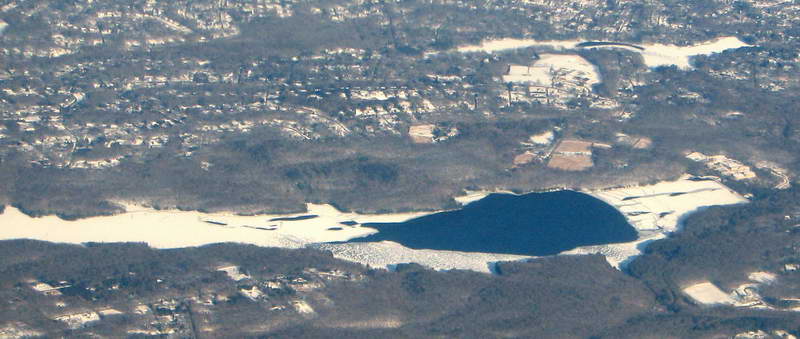Polynyas
 Polynya on Easton Reservoir in southwestern CT. It is about 4000 feet long. Polynyas are large areas of open water surrounded by ice. The water is kept open by wind, warm weather, and/or by currents in the water. The word is borrowed from Russian and is pronounced pă' lǐn yă. They are often a significant hazard on early ice. Polynyas are typically 1000 feet to miles in size. They are a bit less of a hazard than smaller holes as long as they are open because they are so big they are generally easier to see and avoid.
Polynya on Easton Reservoir in southwestern CT. It is about 4000 feet long. Polynyas are large areas of open water surrounded by ice. The water is kept open by wind, warm weather, and/or by currents in the water. The word is borrowed from Russian and is pronounced pă' lǐn yă. They are often a significant hazard on early ice. Polynyas are typically 1000 feet to miles in size. They are a bit less of a hazard than smaller holes as long as they are open because they are so big they are generally easier to see and avoid.
On lakes, were currents are usually a minor consideration, they appear to be associated with deeper water that takes longer to get fully cooled off. Our experience so far is that they do not occur in the same areas every year which suggests a more complex reason for existence than just deep areas. Once formed they are so big that wind and waves impact their evolution more than with the little guys.
When they do freeze they can do so fitfully with lots of new ice holes and variable ice thickness. The ice on a newly frozen Polynya needs to be checked out especially carefully and fully if you venture out on it.
 The northern edge of a recenly skinned polynya on the Inland Sea, Lake Champlainin late January. The wind has blown water over the ice. With a skating pole we found many weak areas along the edge. The estimated size of this poynya is 2 by 4 miles. Its outline was still visible in early March.
The northern edge of a recenly skinned polynya on the Inland Sea, Lake Champlainin late January. The wind has blown water over the ice. With a skating pole we found many weak areas along the edge. The estimated size of this poynya is 2 by 4 miles. Its outline was still visible in early March. The solid blue is the area of the frozen polyna on the Inland Sea in early March 2010. The blue line is its estimated size in late January.
The area this polynya covered is the widest-deepest part of the Inland Sea but most years the whole thing is in by early-mid January.

